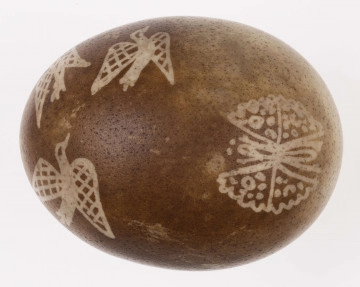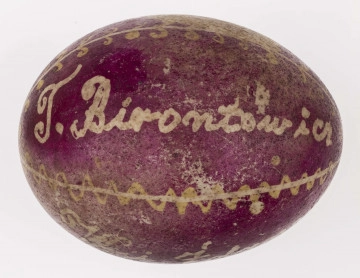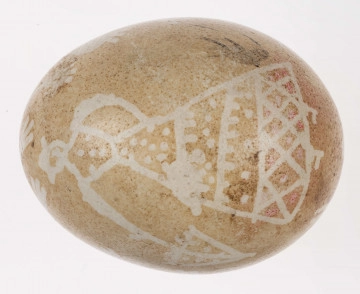
Easter egg
1901 — 1920
National Museum in Lublin
Part of the collection: Folk Art of the Lublin Region (17th–1st half of the 20th c.)
An Easter egg is an attribute of Easter. The egg was a symbol of life, fertility, love and strength, and the symbolism of ornaments written on it played an important magical role. In the Lublin region, eggs were most often decorated using the batik technique, which involved writing on a pattern with melted wax with the help of a marker made of sheet metal in the form of a funnel set on a stick. The etching technique was also used (which involved discolouring the background of a colourful wax-written Easter egg by placing the egg in acid, for example from cabbage) or scratching the design into the surface of the shell with a sharp tool. Single-coloured Easter eggs, known as "kraszanki", were also made. Natural plant dyes were used, such as those made from onion skins, beetroot juice, oak bark, fork seeds or young rye shoots (see also E/1117/ML).
One of the written ornamental motifs was the tree of life - an image of reborn vegetation with inexhaustible fertility, a cyclic of renewed vitality. In Polish folk culture, not only in the Lublin region, it was associated with a Christmas tree and a Christmas tree, a wedding rod made of pine and colourfully decorated, an Easter palm, a green branch of gaik (maypole), birch branches associated with Pentecost and Corpus Christi. This ornament took the form of a tree, a bush, a bouquet in a vase or basket, a branch, a leaf, a flower. Among the patterns of Lublin Easter eggs were stylisations of fir or spruce, ferns and various species of plants, flowers and bushes, more often fantastic than imitated from nature.
The ethnographic collection of the National Museum in Lublin contains some 2,500 Easter eggs made by artists from the Lublin region. Most of them were made in the years 1950-1980, while a significant number (around 500), unfortunately of unknown authorship, date from the early 20th century. The presented Easter egg belongs to the oldest group.
Author / creator
Dimensions
cały obiekt: height: 5,5 cm
Object type
Easter egg
Technique
batik
Material
wax, plant-based pigment,
Creation time / dating
Creation / finding place
Owner
The National Museum in Lublin
Identification number
Location / status

unknown
1901 — 1920
National Museum in Lublin

unknown
1901 — 1920
National Museum in Lublin

unknown
1901 — 1920
National Museum in Lublin
DISCOVER this TOPIC
Castle Museum in Łańcut
DISCOVER this PATH
Educational path
0/500

We use cookies to make it easier for you to use our website and for statistical purposes. You can manage cookies by changing the settings of your web browser. More information in the Privacy Policy.
We use cookies to make it easier for you to use our website and for statistical purposes. You can manage cookies by changing the settings of your web browser. More information in the Privacy Policy.
Manage cookies:
This type of cookies is necessary for the website to function. You can change your browser settings to block them, but then the website will not work properly.
WYMAGANE
They are used to measure user engagement and generate statistics about the website to better understand how it is used. If you block this type of cookies, we will not be able to collect information about the use of the website and we will not be able to monitor its performance.